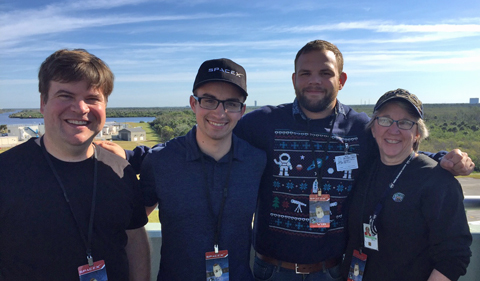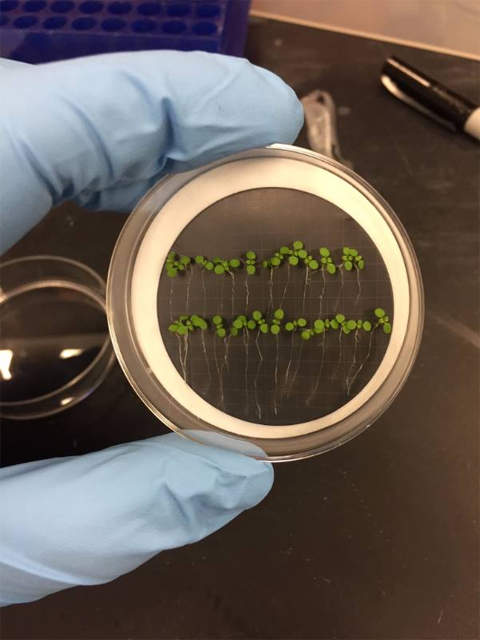Editor’s Note: Myers is a graduate student in Environmental & Plant Biology and Molecular and Cellular Biology.

OHIO team watches the Dragon takeoff–and the return of stage 1 to Cape Canaveral.
By Alexander Meyers, from his Facebook page
Graduate Student in Environmental & Plant Biology
HEY EVERYBODY— I’M GOING TO SPACE!! Well, not me personally… but the launch of SpaceX-CRS13 resupply mission to the International Space Station will be carrying the materials I’ll be using for the remainder of my Ph.D. research.
EMCS-PGP (European Modular Cultivation System-Plant Gravity Perception) is an experiment in which 1,680 seedlings will be grown aboard the International Space Station to examine the cellular and molecular mechanisms that govern gravity sensing and response in plants. I get to do all of the tissue processing, RNA extractions, and sequencing analysis!

Seedlings like those that will grow in space
Why am I telling you this? Because you can watch! Our seeds will go up next week on SpaceX Commercial Resupply Mission 13 (Falcon 9 rocket with Dragon capsule), and seedlings will be returning in March of 2018 (hopefully) upon splashdown of the Dragon capsule from the next ISS resupply. I’ll be posting updates to various social media platforms.
Watch Live on SpaceX’s Website
If you want to tune in to the launch, there will be a live webcast on SpaceX’s website. My involvement in this project is at the grace of its architect and mastermind, Dr. Chris Wolverton. Chris’s university did a nice write-up about him and this project last year. If you’re curious about other happenings in the Wyatt Lab, I direct you to the lab’s webpages: Wyatt Lab at Ohio University and https://wyattlab.wordpress.com/.
Columbus Dispatch: Ohio University
The Columbus Dispatch wrote about the space flight in a story headlined “Ohio Wesleyan biologist blasting plants into space.”
For the experiment, Wolverton and his team are sending seedlings of Arabidopsis thaliana — a plant in the mustard family — to the space station. They’ll send some wild seeds and some mutant seeds, which have a broken gene and are less responsive to Earth’s gravity. Fourteen seedlings are placed on each of 120 small cassette-like membranes. Those cassettes will be placed in hardware aboard the space station, where the crew will apply varying levels of gravity, from zero-gravity to an Earth-like 1 G….
Wolverton and Madonich will receive and begin analyzing near-real-time images of the plants as they’re in space. The plants also will be frozen and brought back for further study of their gene expressions in the spring, in collaboration with researchers at Ohio University.



















Comments